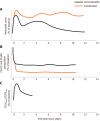Neutrophil kinetics and function after major trauma: A systematic review
- PMID: 34616661
- PMCID: PMC8462018
- DOI: 10.5492/wjccm.v10.i5.260
Neutrophil kinetics and function after major trauma: A systematic review
Abstract
Background: Immune dysfunction following major traumatic injury is complex and strongly associated with significant morbidity and mortality through the development of multiple organ dysfunction syndrome (MODS), persistent inflammation, immunosuppression, and catabolism syndrome and sepsis. Neutrophils are thought to be a pivotal mediator in the development of immune dysfunction.
Aim: To provide a review with a systematic approach of the recent literature describing neutrophil kinetics and functional changes after major trauma in humans and discuss hypotheses as to the mechanisms of the observed neutrophil dysfunction in this setting.
Methods: Medline, Embase and PubMed were searched on January 15, 2021. Papers were screened by two reviewers and those included had their reference list hand searched for additional papers of interest. Inclusion criteria were adults > 18 years old, with an injury severity score > 12 requiring admission to an intensive care unit. Papers that analysed major trauma patients as a subgroup were included.
Results: Of 107 papers screened, 48 were included in the review. Data were heterogeneous and most studies had a moderate to significant risk of bias owing to their observational nature and small sample sizes. Key findings included a persistently elevated neutrophil count, stereotyped alterations in cell-surface markers of activation, and the elaboration of heterogeneous and immunosuppressive populations of cells in the circulation. Some of these changes correlate with clinical outcomes such as MODS and secondary infection. Neutrophil phenotype remains a promising avenue for the development of predictive markers for immune dysfunction.
Conclusion: Understanding of neutrophil phenotypes after traumatic injury is expanding. A greater emphasis on incorporating functional and clinically significant markers, greater uniformity in study design and assessment of extravasated neutrophils may facilitate risk stratification in patients affected by major trauma.
Keywords: Immunophenotypes; Inflammation; Intensive care units; Multiple trauma; Neutrophils; Systemic inflammatory response syndrome.
©The Author(s) 2021. Published by Baishideng Publishing Group Inc. All rights reserved.
Conflict of interest statement
Conflict-of-interest statement: There are no conflicts of interest to declare.
Figures



References
-
- Australian Institute of Health and Welfare 2020. Injury expenditure in Australia 2015–16. Cat. no. HWE 78. Canberra: AIHW. [cited 21 February 2021]. Available from: https://www.aihw.gov.au/reports/health-welfare-expenditure/injury-expend... .
-
- Pillay J, Hietbrink F, Koenderman L, Leenen LP. The systemic inflammatory response induced by trauma is reflected by multiple phenotypes of blood neutrophils. Injury . 2007;38:1365–1372. - PubMed
Grants and funding
LinkOut - more resources
Full Text Sources

